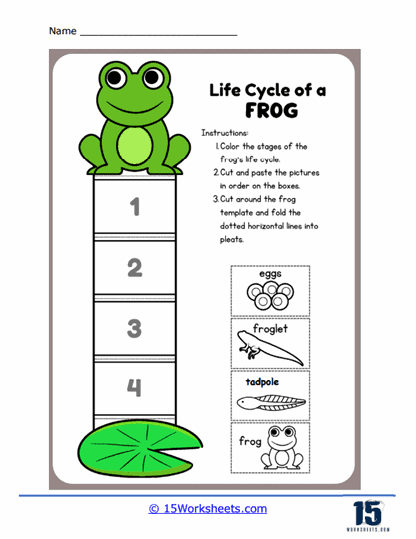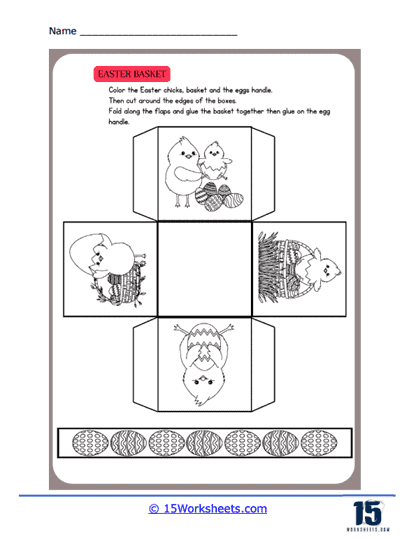Paper Folding Worksheets
All About These 15 Worksheets
At this tender age, children are naturally curious and eager to explore the world around them. It is, therefore, essential to provide them with educational tools that foster creativity, critical thinking, and problem-solving skills while being engaging and enjoyable.
Our paper folding worksheets for preschoolers involve the manipulation of paper to create various shapes, designs, or objects. These worksheets are designed to promote fine motor skills, spatial awareness, and creativity in young children.
These worksheets consist of printed pages with diagrams, patterns, and fold lines that guide children through various paper folding activities. The core feature of paper folding worksheets is the engagement of preschoolers in hands-on folding and unfolding of paper to discover and explore geometric shapes, symmetry, and other mathematical principles.
What Are Paper Folding Worksheets?
Paper folding activities require children to use their fingers and hands to manipulate paper, fold along lines, and create precise shapes. This helps in the development of fine motor skills and hand-eye coordination. Many paper folding worksheets come with step-by-step instructions or diagrams, which help children practice following directions and sequencing skills.
Through folding paper, preschoolers learn about concepts such as symmetry, shapes, and spatial relationships. They develop an understanding of how a two-dimensional sheet of paper can be transformed into three-dimensional objects.
Paper folding activities often allow children to create a variety of objects, animals, or even simple origami figures. This encourages creativity and imaginative play as children explore different ways to fold and arrange paper. Some paper folding projects may be more complex, requiring children to be patient and persistent as they work through the steps to complete the activity.
Types of Exercises on These Worksheets
Fold and Match Shapes – The worksheet provides a shape template on one side and a folded paper section on the other side. Children are instructed to fold the paper along a given line and match the folded shape to the template. This exercise introduces children to the concept of folding and symmetry. It teaches them about mirror images and helps develop spatial reasoning skills.
Create Symmetrical Patterns – The worksheet features an incomplete symmetrical pattern on one side and a blank space on the other. Children are guided to fold the paper along a line of symmetry to complete the pattern. Creating symmetrical patterns enhances understanding of symmetry and spatial relationships. It promotes observation and the ability to recognize mirror images.
Fold and Discover Shapes – Children are provided with folded paper and an outline of a shape or object on the worksheet. They are encouraged to unfold the paper to reveal the hidden shape and compare it to the outline. This exercise demonstrates how folding and unfolding can transform shapes and introduces the idea of congruence (shapes that are identical in size and shape).
Cut and Fold Shapes – The worksheet presents shapes that can be cut out and folded to create three-dimensional objects. Children cut along the dotted lines, fold as indicated, and assemble the object. This exercise teaches spatial visualization as children transform flat shapes into three-dimensional forms. It introduces the concept of polyhedral and encourages problem-solving.
Exploring Lines of Symmetry – The worksheet presents shapes with multiple lines of symmetry. Children are encouraged to fold the paper along different lines of symmetry to observe how each fold affects the shape. This exercise helps children identify and understand multiple lines of symmetry in shapes, enhancing their spatial awareness and symmetry recognition.
Folding and Sequencing – The worksheet provides a sequence of folded shapes, and children are asked to identify and follow the correct sequence of folding to recreate the shapes. Sequencing exercises promote logical thinking and problem-solving skills. Children learn to follow step-by-step instructions and predict outcomes.
Geometric Exploration – The worksheet presents geometric shapes, and children are asked to fold and manipulate the paper to explore concepts such as congruence, similarity, and transformations. Geometric exploration exercises deepen children’s understanding of geometric concepts and promote experimentation and discovery.
Benefits Of Paper Folding Worksheets To Students
The collection of Paper Folding worksheets offers numerous advantages to preschool students:
- Fine Motor Skill Development: Engaging in paper folding activities hones fine motor skills, improving hand control, precision, and hand-eye coordination.
- Spatial Awareness: Completing paper folding tasks promotes spatial understanding as children manipulate shapes, patterns, and three-dimensional objects in a hands-on manner.
- Cognitive Development: Following instructions, solving problems, and making connections between actions and outcomes during paper folding tasks stimulate cognitive growth and problem-solving abilities.
- Creative Expression: Experimenting with different folds, shapes, and designs encourages creative thinking and imaginative expression, fostering artistic development.
- Enhanced Attention Span: Completing intricate paper folding projects helps children develop patience and concentration, enhancing their attention span.
- Sense of Achievement: Successfully completing paper folding worksheets boosts children’s confidence and self-esteem, motivating them to take on more complex tasks.
This collection of Paper Folding worksheets for preschool students serves as a valuable educational tool that nurtures fine motor skills, spatial awareness, cognitive development, and creative expression through hands-on exploration and discovery. These worksheets provide an interactive and engaging way for young learners to engage with shapes, patterns, and three-dimensional objects, setting a strong foundation for future academic success in mathematics, science, and the arts.
Additionally, paper folding activities foster creative thinking and imaginative expression, promoting artistic development and a sense of wonder and curiosity. By incorporating these worksheets into early education, educators and parents can inspire a lifelong love for learning, stimulate cognitive and motor development, and equip children with essential skills and knowledge for future academic and creative pursuits.















